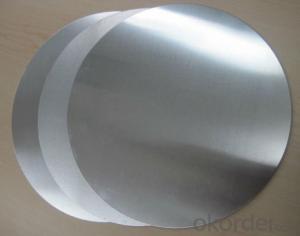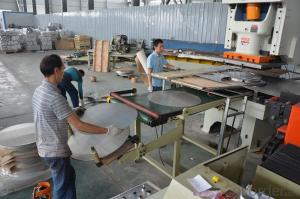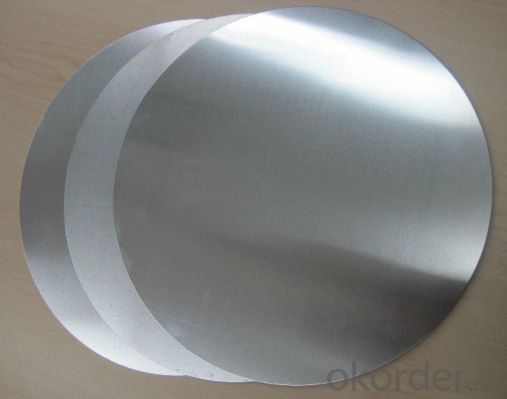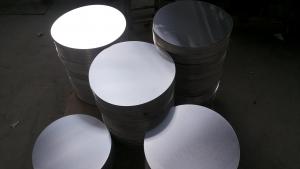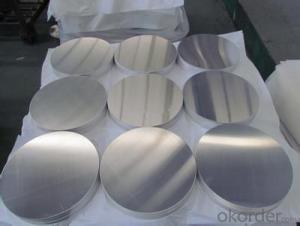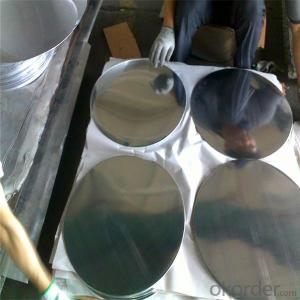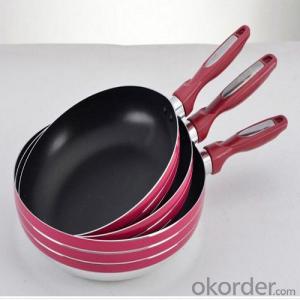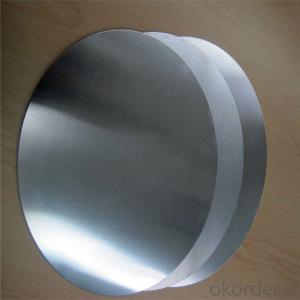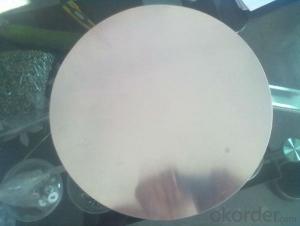Aluminum circle sheet/aluminum circle for cooking utensils
- Loading Port:
- Shanghai
- Payment Terms:
- TT OR LC
- Min Order Qty:
- 1 m.t.
- Supply Capability:
- 6000 m.t./month
OKorder Service Pledge
OKorder Financial Service
You Might Also Like
Specification
Aluminum circle sheet/aluminum circle for cooking utensils
Packaging & Delivery
| Packaging Details: | 25kg/carton-boxes(35*32*19CM) &Fumigation wooden-pallets (110*110*15cm) 20GP can loading 22 Ton,total 21 pallets,20 CBM. |
| Delivery Detail: | within 25 days |
Specifications
1).Excellent Surface Quality for lighting reflectors.
2).Excellent deep drawing and spinning quality.
3).Anodizing Quality
Aluminium circle/Aluminium discs/disks for cooking utensils Cookware
Aluminum disc Surface Finish: Bright & smooth surface, without flow lines, slightly oiled to avoid White rusting.Smooth,Brightly ,No Zone of Fracture ,No Scratched ,No oil Sludge
We enjoy a good reputation among our customers for our aluminum circle with high quality and competitive price, win high appreciation from our clients with the excellent workman-ship and professional ability. The quality matches with ISO 9001 quality management system.
It is equipped with 5 hot tandem rolling line, 4 cold mill production lines, 4 annealing surface machines and a complete finishing equipment.
Specification:
Alloy
Temper
Specification
Thickness
Diameter
1070,1050,3003,1100
O,H12,H14,H16
0.5-5.0mm
100-1200mm
Aluminum disc chemical Properties(WT.%)
Alloy
Si
Fe
Cu
Mn
Mg
Cr
Ni
Zn
Ca
V
Ti
Other
Min.A1
1050
0.25
0.4
0.05
0.05
0.05
-
-
0.05
-
0.05
0.03
0.03
99.5
1070
0.25
0.25
0.04
0.03
0.03
-
-
0.04
-
0.05
0.03
0.03
99.7
3003
0.6
0.7
0.05-0.2
1.0-1.5
-
-
-
0.1
-
-
-
0.15
96.95-96.75
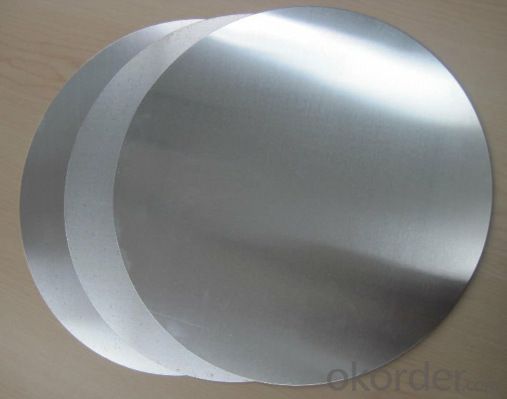
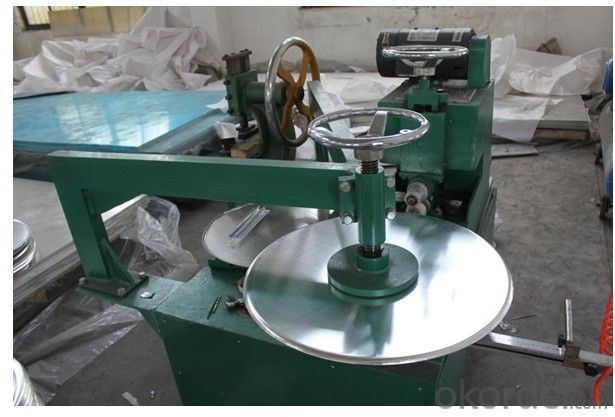
- Q: Are the aluminum sheets suitable for manufacturing aircraft fuselages?
- Yes, aluminum sheets are suitable for manufacturing aircraft fuselages. Aluminum is widely used in the aerospace industry due to its excellent strength-to-weight ratio, corrosion resistance, and easy formability. It provides structural integrity while keeping the weight of the fuselage low, making it an ideal material choice for aircraft manufacturing.
- Q: Hi everyone, I have this problem that I'm somewhat confused about. The problem is:An alloy of aluminum and magensium was treated with sodium hydroxide solution, in which only aluminum reacts to give hydrogen gas:2Al + 2NaOH + 6H20 --gt; 2NaAl(OH)4 + 3H2If a sample of alloy weighing 1.118 g gave 0.1068 g of hydrogen, what is the percentage aluminum in the alloy?How do I account for the magnesium and what stoichiometric relationships would I need to set-up? This is very confusing, but I appreciate the slightest of help on this!Thank you.
- You don't need to worry about the magnesium at all, because it doesn't enter into the reaction. You have a balanced equation for aluminium and hydrogen, and the data given are sufficient: From the equation, you know that 2 moles of aluminium produce 3 moles of H2. 0.1068 g of H2 were produced, so divide this by molecular mass of H2 (2.016) to determine the moles of H2 produced. You know that 3 moles of H2 would have been produced from 2 moles of Al. Therefore, multiply the moles of H2 by 2/3, to determine the moles of Al that were present. Now multiply this number by the atomic mass of Al, to determine the grams of Al. Now divide this number if grams by 1.118 and multiply by 100 to determine % Al present in the alloy.
- Q: Are 101 aluminum sheets suitable for interior design or architectural applications?
- Yes, 101 aluminum sheets are suitable for interior design or architectural applications. 101 aluminum is a common alloy that offers good strength, corrosion resistance, and excellent formability. It can be easily cut, shaped, and fabricated to create various architectural elements such as wall panels, ceilings, furniture, and decorative accents. Additionally, 101 aluminum sheets can be finished with different coatings or textures to enhance their visual appeal and durability. Overall, 101 aluminum sheets are a versatile and cost-effective choice for interior design and architectural applications.
- Q: i need to know these things please....can aluminium withstand the forces of being in a cargo hold on a air freight, can it withstand extreme temps and to what extent an is it microwavable?? please help me
- No metals are microwavable, they will ruin any microwave oven by producing sparks. Even ceramic plates with a little metallic paint eg of silver will spark. Aluminium on its own has little strength but when mixed with small amounts of eg copper or manganese it aquires great strength while remaining light. In addition it has the advantage of being very resistant to oxidation and corrosion. It is certainly used extensively in aircraft construction. Due to being non toxic it used to make cans for beers, soft drinks (sodas) etc However it doesn't stand up well to high temperatures, its melting point is just at 660 degrees celsius, by comparison for iron it is 1540 and tungsten 3420.
- Q: Can aluminum sheets be easily formed into different shapes?
- Aluminum sheets possess the capability to assume diverse forms with ease. Being an exceedingly flexible metal, aluminum can be effortlessly curved, stretched, and shaped without experiencing any cracks or fractures. This property renders aluminum a favored choice across numerous industries, ranging from automotive and aerospace to construction and manufacturing. Utilizing a variety of techniques such as bending, rolling, stamping, and deep drawing, aluminum sheets can be transformed into intricate and intricate designs. Moreover, owing to its lightweight nature, aluminum proves even more manageable during the formation process, requiring less force and energy. Consequently, aluminum sheets exhibit tremendous versatility and adaptability, rendering them exceptionally suitable for the creation of various shapes and structures.
- Q: Can aluminum sheet be welded?
- Indeed, welding aluminum sheet is feasible. Aluminum, a versatile metal, lends itself well to welding through the utilization of diverse techniques like gas tungsten arc welding (GTAW), gas metal arc welding (GMAW), and resistance spot welding (RSW). Nevertheless, the welding of aluminum necessitates specific considerations due to its elevated thermal conductivity and low melting point when compared to other metals. Consequently, selecting the suitable welding process, filler material, and shielding gas is crucial to ensuring a successful weld. Moreover, proper surface preparation, including thorough cleaning and the removal of any oxide layer, plays a pivotal role in achieving a robust and long-lasting weld in aluminum sheet.
- Q: What is the typical sheet size tolerance for aluminum sheets?
- The specific application and industry standards can cause variations in the typical sheet size tolerance for aluminum sheets. Generally, the industry standard for aluminum sheet size tolerance is approximately +/- 0.005 inches. This indicates that the actual size of the aluminum sheet can differ up to 0.005 inches from the specified or desired size. It is worth noting that this tolerance can be adjusted based on the project requirements or customer preferences. Moreover, it is recommended to seek guidance from the manufacturer or supplier of the aluminum sheets for accurate and current information on sheet size tolerances, as they may have their own guidelines or capabilities that differ from the industry standard.
- Q: Are aluminum sheets resistant to impact?
- Yes, aluminum sheets are generally resistant to impact due to their high strength-to-weight ratio and ability to absorb and distribute energy.
- Q: Are the aluminum sheets suitable for manufacturing aircraft wings?
- Yes, aluminum sheets are suitable for manufacturing aircraft wings. Aluminum is widely used in the aerospace industry due to its excellent strength-to-weight ratio, corrosion resistance, and high thermal conductivity. These properties make it an ideal choice for constructing lightweight yet durable aircraft components, such as wings. Aluminum sheets can be easily formed, welded, and machined, allowing for complex wing designs. Additionally, aluminum's low density helps reduce the overall weight of the aircraft, improving fuel efficiency and maneuverability. Overall, the use of aluminum sheets in manufacturing aircraft wings is a common and proven practice in the aviation industry.
- Q: What does aluminum plate "1060-H24" mean?
- Each digit in the 1060-H24 stands for the following meanings:First, a number of Arabia 1 is representative of pure aluminum (aluminum is aluminum content above 99% aluminum, in addition to the beginning and start with 2-8 are 2### for copper and aluminum magnesium alloy, 3### aluminum manganese alloy, 4### alloy, 5### alloy and so on)
Send your message to us
Aluminum circle sheet/aluminum circle for cooking utensils
- Loading Port:
- Shanghai
- Payment Terms:
- TT OR LC
- Min Order Qty:
- 1 m.t.
- Supply Capability:
- 6000 m.t./month
OKorder Service Pledge
OKorder Financial Service
Similar products
Hot products
Hot Searches
Related keywords
